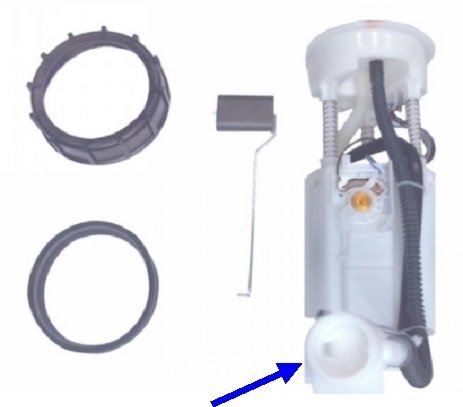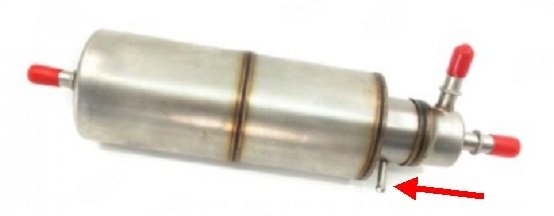This sounds suspiciously like what I've run into four times on three different vehicles, two with carburetors and one with fuel injection. All were caused by a plugged strainer on the fuel pick-up tube inside the gas tank. This is different than the regular fuel filter. In fact, all three of my vehicles were Chrysler products, and their fuel filters typically last the life of the vehicle unless they rust out and start leaking. The strainers in question are inside the gas tank.
When the engine stalls, it takes a few seconds of poor running to let you know it is about to occur. It doesn't stall instantly, as though you had turned the ignition switch off. This is a fuel volume problem, but on fuel-injected engines, it becomes a fuel pressure problem that you can verify with a fuel pressure gauge. With my two carbureted engines, the faster I tried to drive, the sooner the stalling occurred. I typically made it a good ten to fifteen miles before it happened for the first time of the day. After sitting in a puddle of tears on the side of the road for five minutes, the engine could be restarted, and I could drive another three to five miles.
Some instructors will tell you the strainer is collapsing and becoming plugged, and suction from the pump makes that occur faster and faster once it starts to occur. Letting the engine sit for a few minutes gives the strainer a chance to stretch out again. Lately I've been wondering if they're actually becoming plugged with the mold that feeds on the alcohol on today's gas. The first time I ran into this was on a mid'70s Chevy as a student, and my instructor showed it to us. That was before the days of ethanol in gasoline.
Fuel-injected engines act differently due to the fuel return system, fuel pressure regulator, and the extremely high volume of gas that is normally being pumped. On my fuel-injected engine, this occurred twice, about ten years apart. The first time, due to road construction on all three bypasses around Minneapolis, it took me over four hours to nurse it through the city, then, once out on the highway, it ran fine for over two hours until I slowed down for my off-ramp, then it stalled again.
The second time this happened, I was dragging a large tandem axle enclosed trailer that is bigger than the '88 Grand Caravan I was pulling it with. Symptoms had started occurring months earlier, so I had been driving with a fuel pressure gauge clipped to the radio antenna so I could watch it. Normal fuel pressure is around 50 psi. With that heavy load, after about 20 miles, fuel pressure would gradually drop to less than 20 psi, which most engines won't tolerate, and the stalling started to occur at 15 psi. I quickly figured out if I lifted the accelerator pedal for an instant, fuel pressure would instantly pop back up to 50 psi, and I could get another half mile or more before I had to do that again. I nursed it home 55 miles like that just by watching the fuel pressure gauge. That little trick also proved the fuel pump was not the cause of the problem since it was still able to develop normal pressure.
The stalling only occurred when the highest volume of fuel was be pumped, which is during coasting. Dragging the trailer made the symptoms different. In fact, without the trailer, it was a good eight or nine months before stalling symptoms began to occur on a regular basis. Then, it was back to stalling when coasting, and running well when accelerating and at highway speed. Both times, a new $12.00 strainer solved the problem.
There's typically two ways to buy a new fuel pump. One way is to buy just the pump and motor that has to be transplanted into the original housing assembly. A lot of new pumps come with a new strainer included that must be snapped onto the bottom of the housing. The second way is to buy the complete assembly as shown in the first photo. It's ready to drop in, and it comes with a new sending unit for fuel level, and the new strainer already installed. I couldn't find a listing for just the strainer separately for your model. As I mentioned, it costs $12.00 for my '88 Grand Caravan, but there isn't one listed for my '95 or '94 Grand Caravans. Neither of those ever developed this problem. It looks like you might have to buy the new fuel pump assembly / housing to get a new strainer.
My recommendation would be to borrow a fuel pressure gauge from an auto parts store that rents or borrows tools, and hook it up so you can watch it while you're driving. In my city, they make you buy the tool, then you get a full refund when you take it back. Should you decide to keep a tool, you still take it back, then they order or give you a brand new one. If you need it, here's a link to an article on how to use the pressure gauge:
https://www.2carpros.com/articles/how-to-check-fuel-system-pressure-and-regulator
Remember, this is a fuel volume problem, but it shows up as a fuel pressure problem when volume can't keep up to demands. If you want me to, I can explain why fuel volume goes up during coasting.
A potential clue that I never had the chance to try is to remove the vacuum hose going to the fuel pressure regulator, and plug it. That will mimic low manifold vacuum, similar to accelerating or high load conditions. Fuel volume will go down at that time. That makes what little volume that can still get through be enough to keep pressure up to near normal. The engine will run rich, but I suspect you won't notice anything other than perhaps a little black smoke from the tail pipe. If the stalling still occurs, we'll have to look somewhere else, but this trick will tell us if the strainer is the best suspect. As Paul Harvey used to say, "I'm going to tell you more than I know". This test would be real easy to do on the Chrysler engines I'm familiar with. The second photo shows your fuel pressure regulator assembly which is seriously-different, however, from the red arrow to the right, this looks very much like a typical regulator, and I suspect it works the same way. One port is for the fuel under pressure coming from the pump. One port is for the excess fuel that goes right back into the tank, and one is for the regulated fuel that goes to the injectors. The red arrow is pointing to what looks like the vacuum port. That is the place to pull the vacuum hose off and plug it. Drill bits work great for that. The vacuum port on the canister can be left open. If you pull that vacuum hose off while the engine is running and the pressure gauge is attached, you might see pressure jump up a little. The biggest observation is fuel pressure will not drop when you're coasting.
Images (Click to make bigger)
Sunday, November 8th, 2020 AT 6:25 PM




